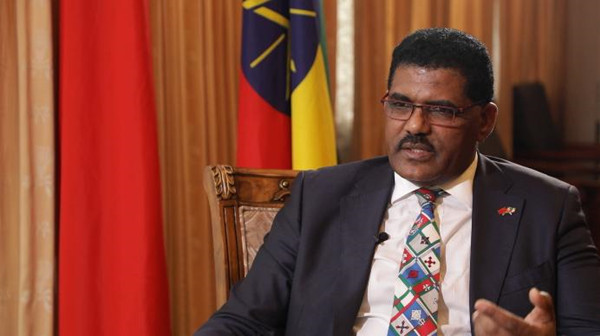Chinese-built railway 'a lifeline' for Ethiopia's economy

Genet Teshome Jirru, Deputy Head of Mission of the Ethiopian Embassy, recently shared his views with China Daily on Ethiopia's railway construction and economic development. [Photo/chinadaily.com.cn]
The question on the mind of many observers of Ethiopia, one of Africa's most dynamic economies with a growth rate of about 10 percent for the last decade, is: will it become "the China of Africa"?
Genet Teshome Jirru, deputy head of the Mission of Ethiopia to China, was humble in his assessment. "Our business is very little. The foundation we depend on is agriculture, which is a very primitive production," he said in an exclusive interview with China Daily. " The departure point must be different."
Nevertheless, "we're making very good progress in the last 15 years. That's why I think most other countries and media called Ethiopia 'the China of Africa,'" he added.
The friendship between China and Ethiopia has a long history. Since the establishment of diplomatic relations in 1970, the cooperation between the two countries has achieved comprehensive results in the fields of politics, economy and social development.
The Chinese-built Addis Ababa-Djibouti Railway, a new "lifeline" connecting Ethiopia's capital with its coastal neighbor to the east, plays a pivotal role in improving Ethiopian traffic, people's lives and economic development.
Ethiopia's economic structure is dominated by its agriculture, which heavily depends on international markets. Most of its import and export transactions need to go through the port of neighboring Djibouti. However, 90 percent of cargo transported from Djibouti to Addis Ababa goes by road.
It usually takes more than a week for a one-way trip, and even more time to travel to other parts of Ethiopia. Logistics inefficiency causes a large amount of cargo to remain in the port of Djibouti or on the road, a bottleneck in the Ethiopian economy.
With the opening of the Ethiopia-Djibouti Railway, cargo transportation time has been shortened from seven days to 12 hours. "This railway project is a lifeline for our economic growth. We take as a lifeline for our continuous economic growth," Genet said.
The Ethiopia-Djibouti Railway is the first electrified railway in East Africa with Chinese standards and equipment. It has a length of 751.7 kilometers, a design speed of 120 kilometers per hour, 45 stations and total investment of about $4 billion.
The construction of the railway was jointly finished by China Railway Group Limited (CREC) and China Railway Construction Corporation Limited (CRCC), both State-owned enterprises (SOEs). It is the first railway with a full industrial chain that Chinese enterprises have built overseas.
Prior to the Chinese-built railway, there was another railroad, largely along the same route but via Dire Dawa, that was built by France in 1897. However this old line became so decrepit that it was suspended in the early 21st century.
In the 1980s, Ethiopia commissioned India to plan a new railway from the capital Addis Ababa to the Red Sea port of Assab, but the plan went bankrupt due to Eritrea's independence and Ethiopia's loss of the entire coastline. Ethiopia then sought help from countries in Europe and the Americas to build the new railway, but all to no avail, until the China team came.
In its 2025 Development Plan, the Ethiopian government vows to build 20 million square meters of factory floor and transfer 2 million agricultural laborers to the industrial sector to transform Ethiopia into a manufacturing power in Africa.
As part of that program, Ethiopia has planned 14 industrial parks across the country, most of which are located along the Ethiopia-Djibouti Railway. In October, one of the 14 parks, the Adama Industrial Park, built by China Civil Engineering Construction Corporation (CCECC), another Chinese SOE, was inaugurated. From the construction of the Ethiopia-Djibouti Railway to the construction of the Awasa Industrial Park, from the operation of the railway to the operation of the industrial park, CCECC stood out among them all.
"In the process of building the railway, we proposed the 'Ethiopia-Djibouti economic model', which is to build a railway to drive economic development along its route, including the construction of industrial parks, and the development of agriculture and tourism," said Li Wuliang, general manager of CCECC. " This idea is in line with Ethiopia's national strategy."
Genet agrees. "When you cluster the industries together, they can exchange knowledge for technology transfer and share know-how," he said.
According to media reports, the Awasa Industrial Park will employ about 60,000 locals and increase Ethiopia's garment exports by $1 billion every year. The park even attracted leaders of Sudan and Liberia to visit.
As the China-proposed Belt and Road Initiative enters its fifth year, the country's cooperation with Ethiopia and Africa at large is set to grow further. China's powerful and competitive SOEs will be a mainstay of that cooperation. According to the State-owned Assets Supervision and Administration Commission of China, the combined profits of China's central SOEs shot up 23 percent to 888 billion yuan ($133 billion) in the first half of this year, while their revenues jumped 10.1 percent to 13.7 trillion yuan ($1.97 trillion).
"Our cooperation with China is significant. As China's economy continues developing, our cooperation will also continue," said Genet. " This is significant for us."



